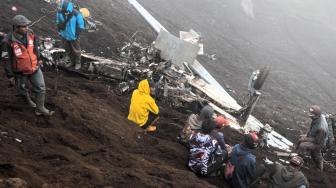
PT DI Plans to Sell More NC-212i Aircrafts, Thailand Will Be First Customer
President Director of PT DI, Gita Amperiawan, highlighted the potential to sell eight NC-212i aircraft to Thailand.

President Director of PT DI, Gita Amperiawan, highlighted the potential to sell eight NC-212i aircraft to Thailand.

Vice Marshal Agustinus Gustaf Brugman explained several challenges encountered by the evacuation team, including difficult terrain.

Indonesia must immediately make the baby steps and strike while the iron is still hot.

TheIndonesia.id - The KF-21 Boramae development program is arguably one of the biggest and most ambitious defense projects between Indonesia and South Korea. It takes governments of the two countries more than a decade to initiate and mature the program. However, some issues persist that may hinder the program from achieving its objectives.
During an Indonesian Next Generation Journalist Network on Korea workshop initiated by the Foreign Policy Community of Indonesia (FPCI) and Korea Foundation, former secretary general at Indonesia’s Ministry of Defense, Air Marshal (Ret.) Eris Herryanto, revealed a set of objectives that Indonesia seeks to achieve from this program.
Among those are a goal to improve national capability to develop fighter aircrafts, including the vital, much-needed human resources and infrastructures.
Furthermore, the Indonesian government also aims to be the “sole supplier” of all components for the Boramae aircraft, including the fuselage, wings, and empennage. In the end, it wants to produce and export the jets to a number of countries across the globe.
Herryanto revealed that based on a study by market research company Teal Group, the worldwide optimistic forecast on the demand for jet developed in the program could reach up to 198 aircrafts between 2024 and 2027. The figure is predicted to slightly decrease in 2028-2031 period (170).
It is worth noting that the number does not include market demand for South Korean and Indonesian air forces at 240 and 48 units, respectively. And it’s quite clear that authorities in Indonesia aims high and is confident about the product’s sales potential.
However, despite all the grand plans, one very crucial problem prevails: the United States (from which some of the technologies in the development are used) applies export limitation (EL) for some of the 129 technologies. As a result, it will, obviously, hinder Indonesia from independently producing and exporting the jet.
“If the US is selling any tool, it will give the tool itself as well as the technology, and there will be export license. [Should it be issued to Indonesia] it would be through cooperation between the Ministry of Defense and the US Department of State,” Herryanto said.
“It has been an obstacle from the start of our program, so we arranged Technical Assistance Agreement, or TAA.”
The agreement, he said, involves the three country and stipulates what technologies can be transferred under the development program.
“From 129 technologies, 120 of them are authorized through the TAA. The remaining nine are still not,” Herryanto explained.
According to him, to resolve the issue, the Indonesian government has to act more aggressively: the Ministry of Foreign Affairs should submit a formal request to the US Department of State to authorize the transfer of export license for the remaining nine technologies.
Similarly, such experience also happened to South Korea during the development of T-50 Golden Eagle aircraft. In a joint effort between the US and Korean Aerospace Industries (KAI), South Korea also did not immediately get the necessary export license.
“South Korea shared their experience to us, and they support us [in our effort to obtain the license from the US],” Herryanto revealed.
The KF-21 Boramae program focuses on the development of fighter jet based on the requirement and operation concept of South Korean and Indonesian air forces. The aircraft is set to be semi stealth and highly maneuverable—as well as having smart avionics with sensor fusion and interoperability concept.
The program was first kick-started in March 2009 when government of the two countries signed letter of intent (LOI).
And the latest development was made in February 2016, when a Ministry of Defense’s Regulation concerning the program was issued in Indonesia.
Herryanto predicted the jet will complete the initial development phases and enter production phase in 2026 or 2028. And only afterward it can become part of Indonesia’s national air force.